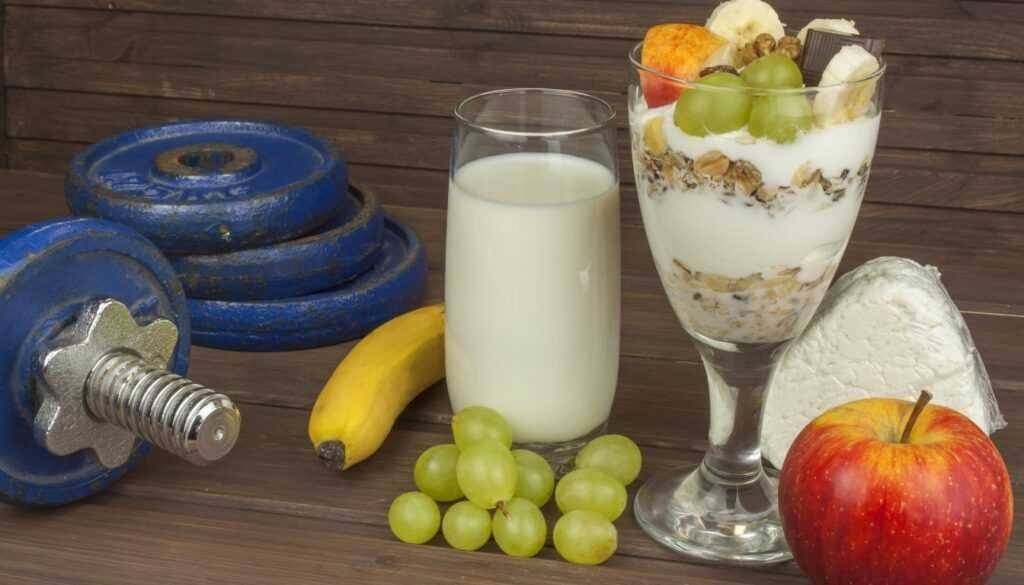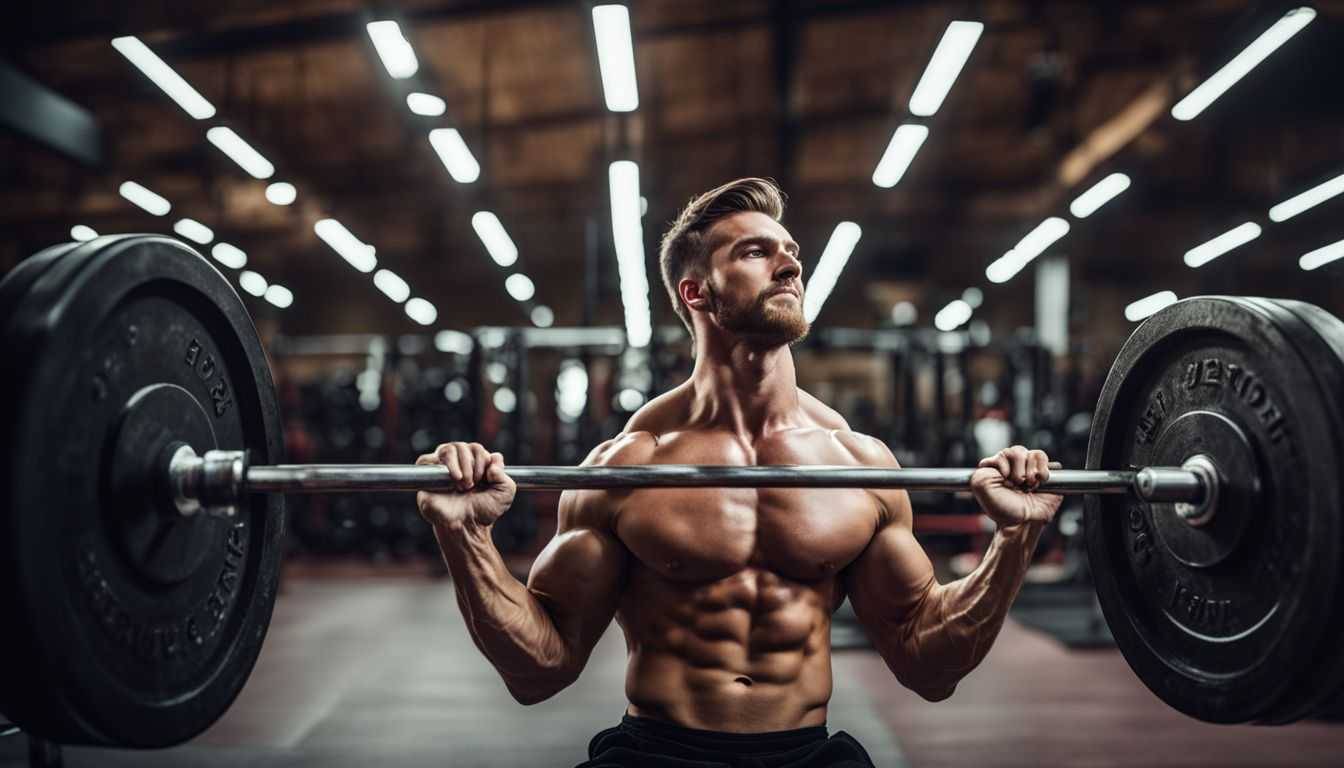Ever felt daunted by the sheer amount of information on building muscle? Believe me, I get it. From years of sifting through facts and myths, as well as trialing methods on myself, I’ve discovered that effective muscle gain is a delicate dance between strategic workouts and balanced nutrition.
This article will help demystify the proven methods of efficient muscle growth for you – prepare to transform your body into a finely chiseled work of art!
Key Takeaways
- Building muscle involves resistance training and proper nutrition. Resistance training, like lifting weights, causes muscles to grow bigger over time. Eating enough protein is important for muscle growth.
- Building muscle has many benefits beyond appearance, including joint support, increased calorie burning even at rest, stronger bones to prevent diseases like osteoporosis, and better blood sugar control.
- To maximize muscle building: lift heavy things often (resistance training), eat more food to fuel muscles and increase metabolism, focus on working big muscle groups like the chest and legs.
- Important principles of muscle building include heavy training to challenge muscles and stimulate growth, rest and recovery for repair and growth of muscles during sleep, consuming carbs post-workout for energy replenishment in the muscles, implementing progressive overload challenge by gradually increasing difficulty in workouts over time,maximizing time under tension during exercise.
Understanding Muscle Building

Muscle building, also known as muscle hypertrophy, is the process of increasing the size and strength of your muscles through targeted exercise and proper nutrition.
Muscle Hypertrophy
Muscle hypertrophy is when our muscles grow bigger. This happens with resistance training, like lifting weights. You must give effort and keep adding weight for your muscles to grow.
Squats and deadlifts are good because they use many joints at once. They can make our muscles get big fast. We also need to eat a lot of protein for our muscles to grow well. Each day, we should eat 1 gram of protein per pound that we weigh.
Benefits of Building Muscle
Building muscle does more than make you look strong. It is good for your health too. Building up muscle helps to support your joints. This can stop harm to your knees and hips later in life.
There are other perks of building muscle as well! When you have more muscle, your body burns more calories — even when resting! Muscles also help keep bones strong to prevent diseases like osteoporosis.
Finally, working on muscles helps control blood sugar levels in the body. Lower blood sugar means lower odds of getting heart disease, strokes or nerve issues.
Muscle’s Role in Calorie Burning, Bone Strength and Blood Levels
Muscles can do more than just make us look strong. They help to burn calories, even when we are at rest. The more muscles you have, the more calories your body burns. This is because muscles need energy to keep going.
Strong muscles also make our bones strong. When you build muscle, your bones become stronger too. Strong bones are less likely to break or get diseases like osteoporosis.
Your blood levels are also better if you have good muscles. Blood sugar levels stay steady and the risk of heart disease goes down. Nerve problems get fewer as well.
This means that muscles keep us healthy in many ways!
Basics of Building Muscle

To maximize muscle building, it is important to eat more and focus on working big muscle groups.
Maximizing Muscle Building
To max out your muscle building, you have to work hard and stick with it. We want to see growth in our bodies, so we lift heavy things often. It’s called resistance training. This makes our bodies work hard and causes little tears in the muscle fibers.
Don’t worry – this is a good thing! Our bodies get busy fixing these tears and making them even stronger than before. This is how muscles grow bigger over time! Eating protein helps this process along as well, so don’t forget to add some to each meal or snack.
Importance of Eating More
Eating more is really important when it comes to building muscle. It’s not just about lifting weights and doing exercises, but also fueling your body with the right nutrients. When you eat more, it helps your muscles grow and get stronger.
Plus, having more muscle mass can increase your metabolism, which means you burn more calories even when you’re resting. Eating enough food is also crucial for keeping your bones strong and preventing conditions like osteoporosis.
And let’s not forget that gaining strength through muscle building can help reduce the risk of heart disease, stroke, and nerve problems. So remember, eating more is key for long-term muscle gain!
Focusing on Big Muscle Groups
Building muscle requires focusing on big muscle groups. This means targeting major muscles like the chest, back, legs, and shoulders. By prioritizing these larger muscle groups in your workouts, you can maximize your efforts and see better results.
Working out these big muscles not only helps increase muscle mass but also promotes overall strength and stability. It is important to include exercises such as squats, bench presses, deadlifts, and shoulder presses in your training routine to effectively target these big muscle groups.
Remember that when it comes to building muscle, quality over quantity is key!
Principles of Muscle Building

In this section, we will discuss the key principles of muscle building. From heavy training to rest and recovery, these strategies are essential for maximizing your gains. Don’t miss out on valuable tips that can take your muscle-building journey to the next level!
Heavy Training
When it comes to building and maintaining muscle mass, heavy training plays a crucial role. This type of training involves lifting weights or performing resistance exercises that challenge your muscles.
Heavy training helps strengthen bones, which is important for preventing conditions like osteoporosis. It also has positive effects on blood sugar levels, reducing the risk of heart disease, stroke, and nerve problems.
Additionally, heavy training improves everyday functionality by making activities like climbing stairs or carrying heavy bags easier. Moreover, it stimulates muscle hypertrophy, which refers to the increase in growth of muscle cells.
Importance of Rest and Recovery
Rest and recovery are incredibly important when it comes to building and maintaining muscle mass. When we exercise, our muscles become damaged, which is actually a good thing because it triggers the muscle repair process.
But for this repair process to happen effectively, we need to give our bodies enough time to rest. This means taking regular breaks between workouts and getting enough sleep at night.
During sleep, our muscles have the opportunity to repair themselves and grow stronger. So make sure you’re giving yourself plenty of rest and recovery time so that your muscles can properly heal and grow bigger and stronger.
Carbs Consumption Post-Workout
Consuming carbohydrates after a workout is important for muscle recovery and growth. This is because carbs provide the energy needed to replenish glycogen stores in the muscles. When glycogen stores are low, it can lead to muscle breakdown instead of muscle building.
Including carbs in your post-workout meal or snack helps prevent this from happening by providing the necessary fuel for repair and growth. Examples of healthy carb sources include fruits, whole grains, and starchy vegetables like sweet potatoes.
Remember that it’s also essential to pair carbs with protein for optimal muscle recovery and growth.
Progressive Overload Challenge
In order to build and maintain muscle mass, it is important to implement the progressive overload challenge. This means gradually increasing the difficulty of your workouts over time.
To trigger muscle growth, you need to increase the load or resistance on your muscles. For example, when implementing the progressive overload challenge, aim for three sets of 10 repetitions at a certain resistance.
It’s also recommended to focus on multi-joint exercises, as they allow you to lift heavier weights and promote muscle growth. The progressive overload challenge is a key principle in muscle building that helps you continuously challenge your muscles and stimulate their growth.
Maximizing Time Under Tension
To build muscle effectively, it is important to maximize the time that your muscles are under tension during workouts. This refers to the amount of time your muscles are working and experiencing strain.
One way to do this is by slowing down the tempo of your exercises. By using lighter weights and focusing on controlled, deliberate movements, you can increase the time under tension for your muscles.
This can trigger muscle growth, also known as hypertrophy. So remember to take it slow and focus on quality movements during your workouts to maximize time under tension and get those gains!
Essential Tips for Gaining Muscle

Here are five essential tips for gaining muscle that will help you maximize your training and see better results. Want to know what they are? Keep reading!
Determining Repetition Targets
To determine the number of repetitions to aim for when building muscle, a good target is three sets of 10 repetitions. This means that you perform an exercise or lift a weight ten times in each set, for three total sets.
This repetition range allows for enough resistance and effort to stimulate muscle growth without overloading the muscles. It’s important to find a weight that challenges you but still allows you to complete all the reps with proper form.
By targeting these repetition targets, you can effectively work your muscles and promote muscle hypertrophy, which is the process of increasing muscle size and strength through exercise.
Choosing the Right Weight
Choosing the right weight is crucial for gaining muscle. When selecting a weight, it should be challenging enough to stimulate muscle growth and hypertrophy, but not so heavy that it compromises your form or causes injury.
It’s important to start with a weight that allows you to perform each exercise with proper technique. Gradually increase the load as you become stronger and more comfortable. Multi-joint movements, like squats and push-ups, are effective because they challenge multiple muscles at once, leading to greater muscle growth.
Remember to also focus on progressive overload by gradually increasing the resistance on your muscles over time. Lastly, don’t forget about adequate protein intake as it is essential for muscle hypertrophy.
Selecting Effective Exercises
To effectively build muscle, it’s important to choose exercises that target multiple muscles at once. These are called compound exercises and they include movements like squats, deadlifts, and bench presses.
Compound exercises allow you to lift heavier weights and stimulate more muscle growth. It’s also a good idea to start with bodyweight exercises if you’re a beginner before adding weights.
This helps you develop proper form and build a foundation of strength. Regularly assessing your strength and having a progressive exercise plan is key for continuous muscle gains. So remember, focus on compound exercises and gradually increase the intensity of your workouts to see the best results in gaining muscle mass.
Structuring Workouts to Prevent Overtraining
To prevent overtraining and promote muscle gain, it’s important to structure your workouts properly. This means incorporating rest days into your schedule to allow your muscles time to recover and grow.
Overtraining can actually hinder muscle growth, so giving yourself adequate rest is essential.
In addition to rest days, you should also vary the intensity and duration of your workouts. This helps prevent overuse injuries and keeps your body from adapting too quickly to the same exercises.
Consider including different types of exercises, such as strength training and cardio, in your workout routine for a well-rounded approach.
Another important aspect of structuring workouts is listening to your body. Pay attention to any signs of fatigue or pain during or after workouts, and adjust accordingly. It’s better to take an extra day off if needed rather than pushing through potential injury.
Nutritional Guide for Muscle Gain
To effectively gain muscle, it’s important to understand the role of nutrition in your journey. This section will provide a comprehensive guide on caloric intake, protein requirements, and the role of carbohydrates and fats in muscle gain.
Understanding Bulking versus Cutting
When it comes to gaining muscle, understanding the difference between bulking and cutting is important. Bulking involves consuming more calories than your body needs in order to build muscle mass.
This means eating a caloric surplus and focusing on strength training exercises. On the other hand, cutting involves consuming fewer calories than your body needs in order to reduce body fat while maintaining muscle mass.
This requires paying attention to nutrition and adjusting your workout routine accordingly. Both bulking and cutting have their own benefits and goals, so it’s important to understand which approach is right for you based on your specific fitness goals.
Caloric Intake for Muscle Gain
Caloric intake plays a crucial role in muscle gain. The principle is simple; to gain muscle, we need to consume more calories than our body burns in a day. The extra calories provide the energy required for muscle growth and recovery after workout sessions. However, it’s important to note that these should be nutrient-dense calories, not empty ones from junk food. Let’s break down the importance and effects of caloric intake for muscle gain in the table below:
| Caloric Intake for Muscle Gain | Reason | Effects |
|---|---|---|
| Increase Total Caloric Intake | Extra calories are required to provide energy for muscle growth and recovery after workouts. | Supports muscle growth and reduces recovery time, leading to faster muscle gain. |
| Consume Nutrient-Dense Calories | Proper nutrition is required to facilitate muscle repair and growth. | Enhances muscle development and helps maintain overall health. |
| Avoid Empty Calories | Empty calories from junk food lack proper nutrition which is essential for muscle growth. | Prevents accumulation of unwanted fat and promotes lean muscle mass. |
| Monitor Caloric Intake | Balancing caloric intake is crucial to prevent excessive weight gain while aiming for muscle gain. | Promotes healthy weight management and ensures optimal muscle development. |
Remember, everyone is different, so it’s important to adjust your caloric intake based on your individual body composition, activity level, and muscle gain goals. Our main objective is to fuel our bodies with the right kind of nutrition to achieve healthy and sustainable muscle growth.
Protein Intake for Muscle Gain
When building muscle, adequate protein intake is a crucial factor.
| Source of Protein | Benefits |
|---|---|
| Chicken | Chicken is a lean meat, meaning it’s high in protein but low in fat, making it an excellent choice for muscle recovery. |
| Eggs | Eggs are an inexpensive, easy-to-digest source of high-quality protein, ideal for muscle growth and maintenance. |
| Salmon | In addition to protein, salmon provides heart-healthy omega-3 fatty acids, important for overall health and recovery. |
| Greek Yogurt | Greek yogurt packs a protein punch and also provides beneficial probiotics for gut health. |
| Lean Beef | Lean beef is not just high in protein, but also in essential nutrients like iron and vitamin B12, supporting overall health along with muscle gain. |
| Soybeans | For vegetarians and vegans, soybeans offer a plant-based protein source, rich in fiber and antioxidants. |
To promote muscle hypertrophy, aim for a protein intake of 1 gram per pound of body weight per day. This level of consumption supports the continuous muscle gains essential for muscle building. Remember, incorporating a variety of protein sources into your diet can maximize your nutritional intake and promote optimal muscle growth.
Role of Carbs and Fats in Muscle Gain
Carbohydrates and fats play important roles in muscle gain. Carbs provide the energy needed for intense workouts, allowing you to train harder and build more muscle. It’s best to choose complex carbohydrates like whole grains, fruits, and vegetables for sustained energy levels throughout your workouts.
On the other hand, fats are important for hormone production and provide long-lasting energy. Healthy sources of fats include avocados, nuts, seeds, and olive oil. So make sure to include both carbs and fats in your diet to support muscle growth along with protein-rich foods like chicken, eggs, salmon, Greek yogurt, lean beef, and soybeans.
The Rate of Muscle Gain
When it comes to gaining muscle, the rate of progress varies from person to person. Factors like genetics, age, and training intensity play a role in how quickly you can build muscle.
It’s important to remember that muscle growth takes time and consistency. You won’t see results overnight, but with dedication and consistency, you can make progress over time.
By following a structured workout program and eating a balanced diet that supports muscle growth, you can optimize your rate of muscle gain. It’s also important to give your muscles enough rest and recovery time between workouts to allow them to repair and grow stronger.
Remember that everyone’s journey is different, so don’t compare yourself to others or get discouraged if your progress isn’t as fast as someone else’s. Focus on making steady improvements and celebrate each milestone along the way.
With patience and perseverance, you will see progress in building muscle mass over time.
FAQs: How to Gain Muscle
What should I do to gain muscle mass fast?
To gain muscle mass fast, you need to follow a training plan that includes progressive increase of weight load and core exercises like calisthenics and weightlifting.
Can skinny guys build more muscles?
Yes, skinny guys can gain muscle with a good diet plan, regular exercise for weight loss, and by increasing their protein intake using items like the Essential Protein Daily Shake.
Is it possible to gain muscle without weights at home?
Absolutely! You can use exercises that focus on your own body’s resistance such as push-ups or squats which helps to gain muscle in arms and other parts of the body at home.
How can women effectively build muscles?
Just like men, women also achieve significant gains by following a workout plan inclusive of strength training, healthy eating habits and maintaining proper hydration levels.
Can I grow muscles while also losing fat?
Sure! By doing strength-based workouts while following correct breathing techniques taught by a certified personal trainer; one may lose fat but still put on some leaner muscles.
Are there any foods that help in gaining muscles quickly?
Eating high-protein foods after workouts aids repair and rejuvenation of tissues leading to quicker growths of muscular fiber size.
Conclusion
In conclusion, building muscle takes consistent effort and dedication. It offers benefits like joint support, increased metabolism, and stronger bones. By following strategies such as progressive overload and focusing on multi-joint movements, you can achieve your muscle-building goals and enjoy a healthier and more functional body.
Remember to prioritize nutrition, rest, and recovery to optimize your results. Start taking action today to build and maintain muscle mass for a stronger and healthier future.
